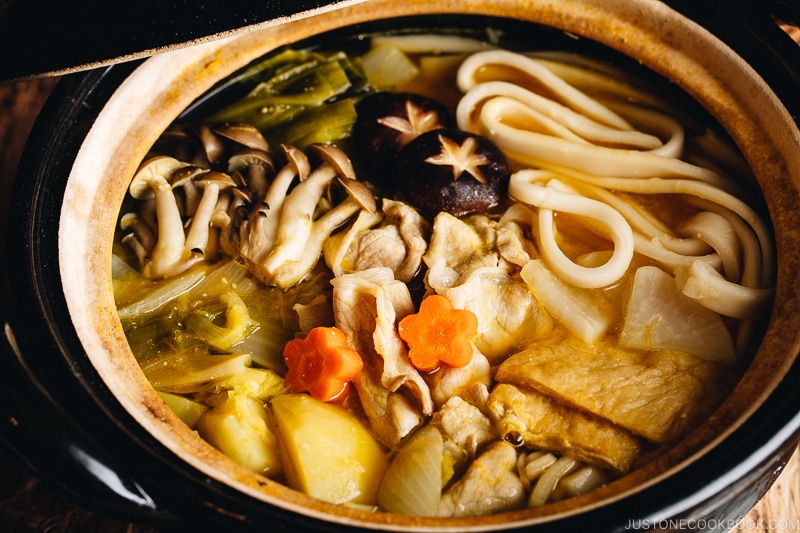
Filled with starchy vegetables, meat, and flat noodles in miso-based dashi broth, this hearty noodle soup called Hoto is a popular regional food from Yamanashi prefecture in Japan.
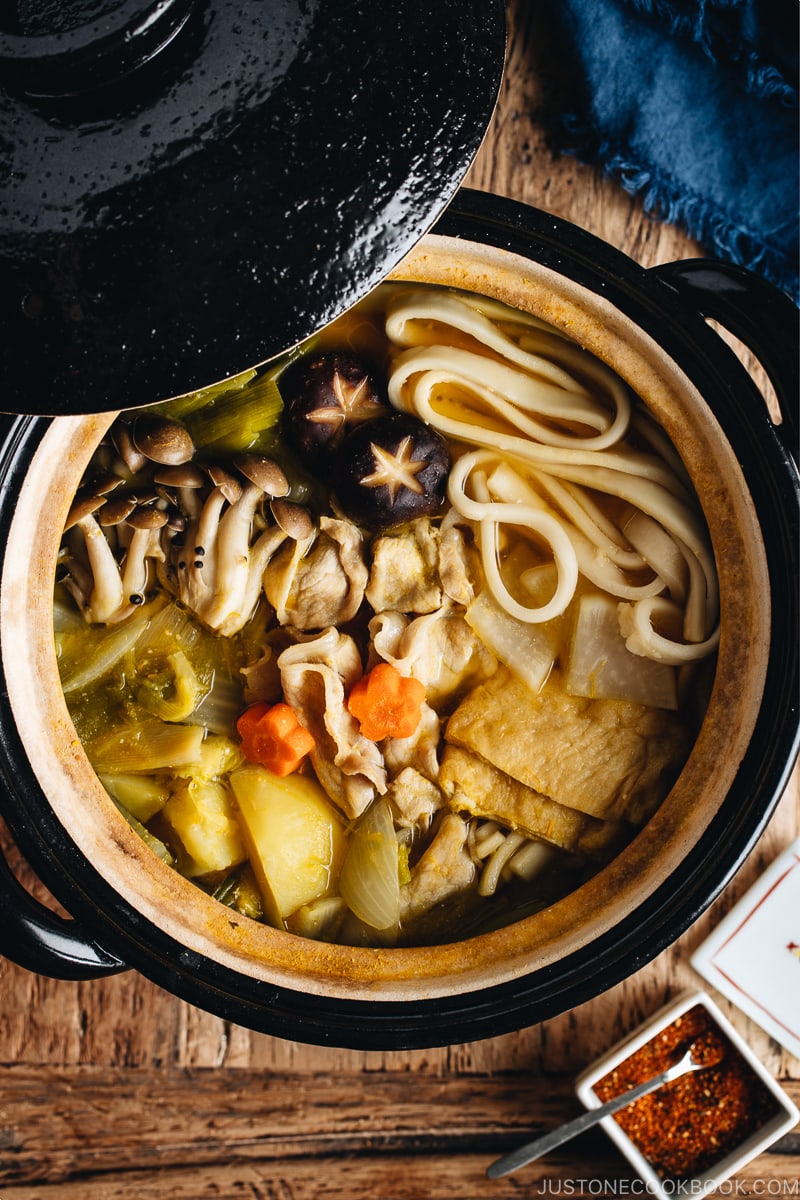
For the past several years, my family has visited Yamanashi prefecture a number of times. Yamanashi is in the proximity of Tokyo and Yokohama where my family lives, and the convenience brought us to a few different ryokans (Japanese-style inn) to enjoy delicious food and onsen (hot springs).
Each trip, we got to enjoy the famous regional noodle soup called Hoto (pronounced as [Hōtō]). This hearty, homey, rustic noodle soup is especially comforting in winter months and I couldn’t wait to share the recipe after our recent trip in January.
What is Hoto?
Hoto (ほうとう, 餺飥) is a miso-based noodle soup originated in Yamanashi, Japan. It’s known as a regional food from Yamanashi, and it consists of vegetables (especially kabocha squash), meat, noodles in a dashi broth that is seasoned with local Koshu (甲州) or Shinshu (信州) miso.
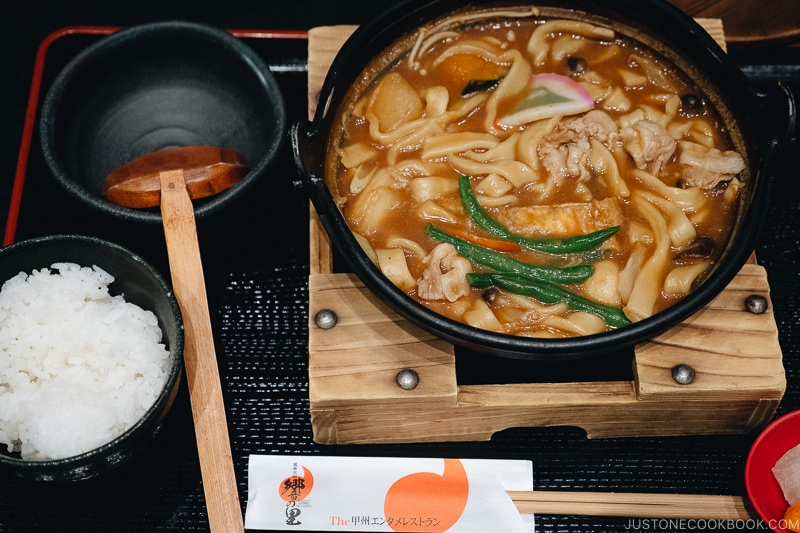
The noodles in this soup are a bit different from udon noodles. The dough has a tougher texture and is not mixed with salt or left to sit. Hense, the noodles are more doughy and lack of elasticity. It has a lot more similarity to dumplings than noodles.
Since these noodles are not required to parboiled prior to adding to the soup, they are cooked raw in the soup along with the other ingredients.
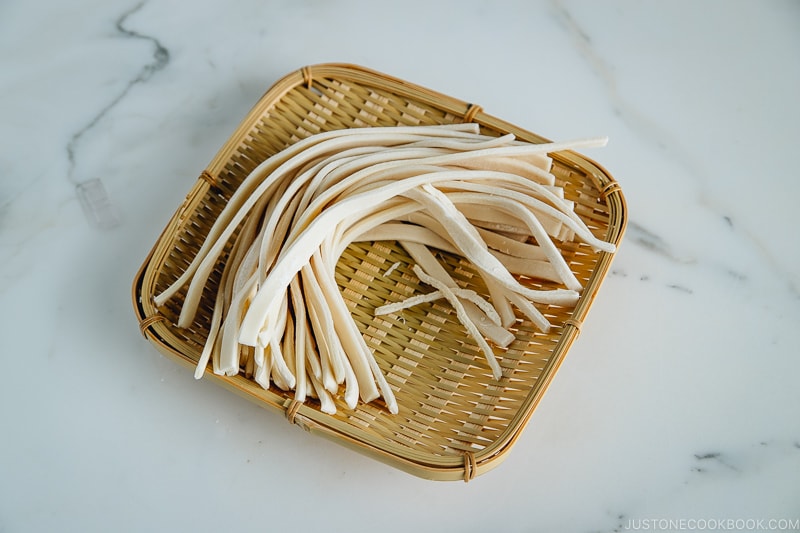
The origin of Hoto was due to shortages in local rice crops. The rice fields in Yamanashi were turned into wheat farming, and flour products like hoto noodles were invented to counter food scarcity.
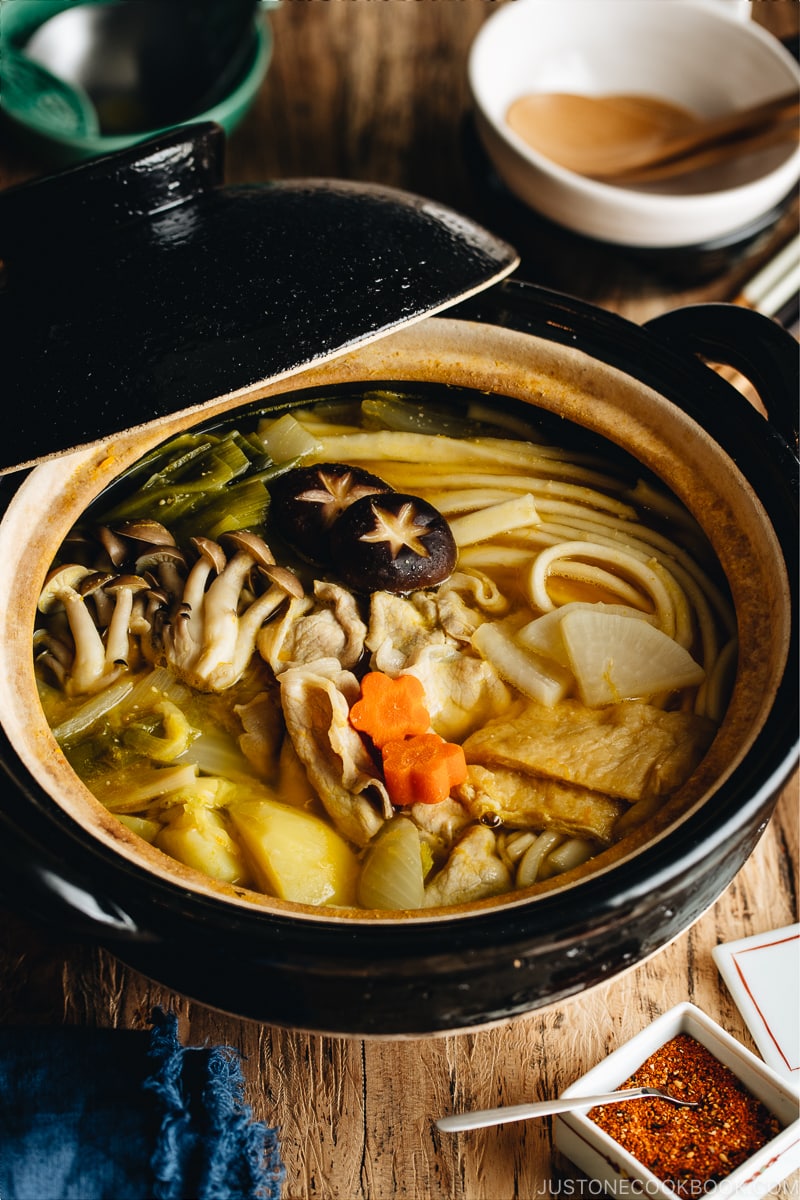
Ingredients You Need for Hoto Noodle Soup
This home-style noodle soup is a lot more flexible when it comes to ingredients. You can use what you have in the fridge and it would work just fine. Fresh hoto noodles are impossible to find outside of Yamanashi prefecture, so some people use udon noodles instead. You can also make hoto noodles from scratch. All it needs is flour and water. Be sure to check out the Notes section in the recipe below if you’d like to make the noodles yourself. It’s easier than you think!
Proteins of your choice:
- Pork
- Chicken
- Tofu
Vegetables
- Kabocha squaash
- Carrot
- Negi (long green onion) or leek or green onion
- Daikon radish
- Potato
- Napa cabbage
- Any seasonal vegetables
Others
- Aburaage (deep-fried tofu pouch)
- Shiitake mushrooms
- Shimeji mushrooms
- Hoto noodles
- Dashi (Japanese stock) – I used both kombu dashi and anchovy stock (iriko dashi) in flavoring the broth as it is how it’s done traditionally. Anchovies lend a stronger and flavorful broth but feel free to use other dashi that is available. For vegetarians, you can use kombu dashi or/and shiitake dashi.
- Condiments (miso, sake, mirin)
In Yamanashi, you’d find hoto noodles being served in an iron pot, which keeps the noodles and soup hot. At home, I use my versatile donabe (Japanese earthenware pot) to cook and serve the dish. No donabe? You can certainly use any soup pots (heavy cast iron or clay pots are best).
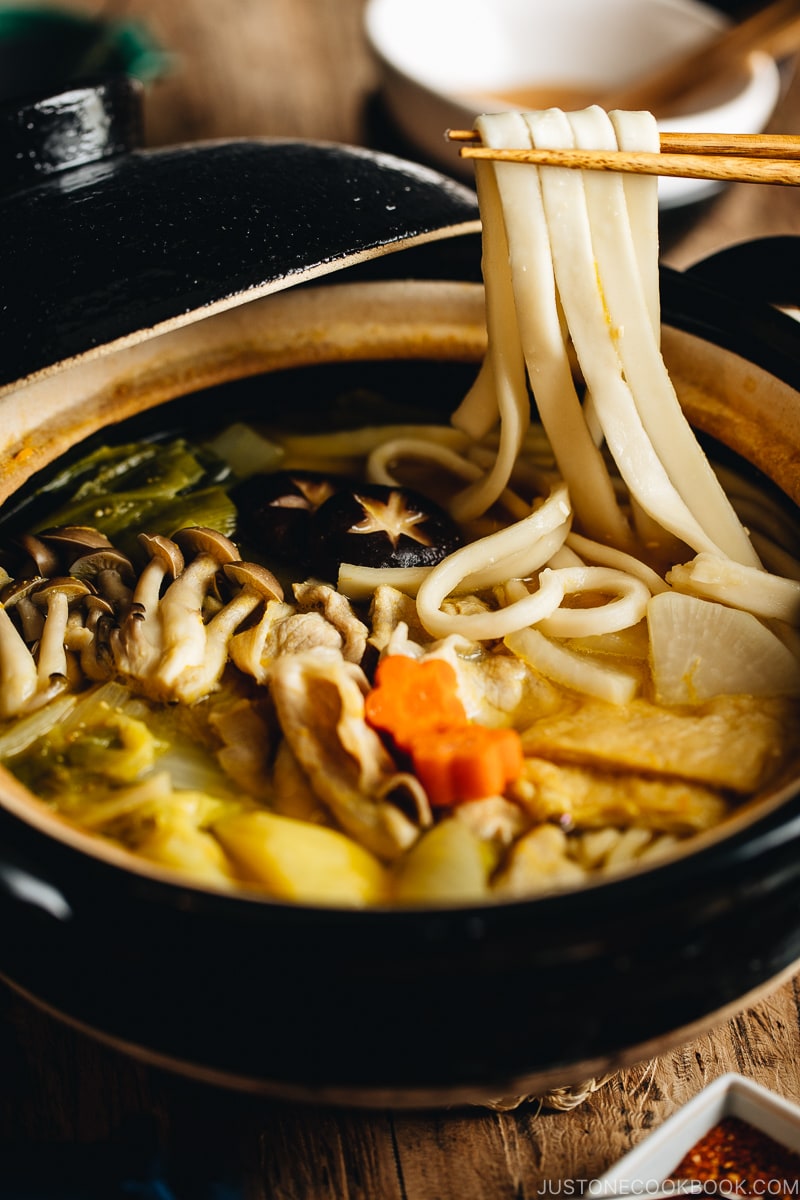
Mutenka Enjuku Koji Miso for Hoto Noodle Soup
The main flavor for the noodle soup is dashi made with anchovies and kombu that is seasoned with local miso.
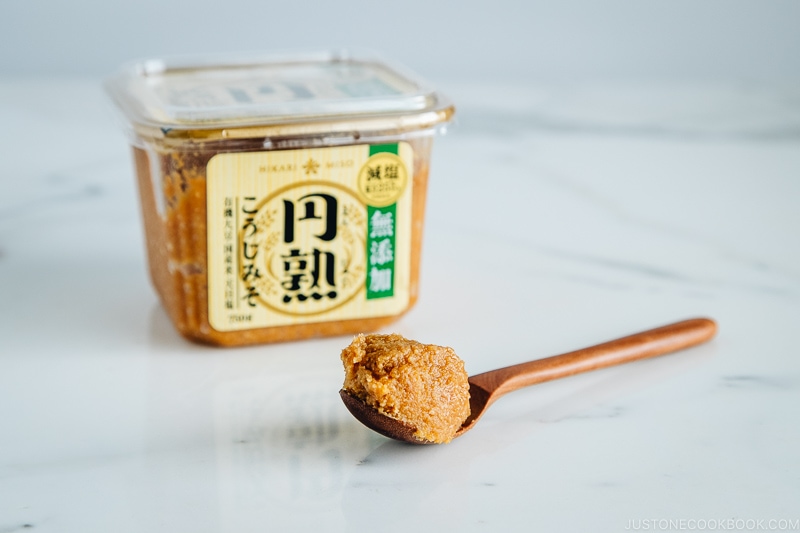
Mutenka Enjuku Koji Miso (with a green label) from Hikari Miso® contains 25% less sodium than Mutenka Enjuku Koji Miso. It still has a full flavor and umami yet no food additives or preservatives are used in this genuine koji miso. It is so delicious, and it’s one of my favorite miso to enjoy in all types of recipes that require miso.
If you already have miso in your fridge, you can definitely use it for the broth before you venture into other types of miso. You can read all about miso to be familiar with different types of miso.
Where you can buy different types of miso by Hikari Miso®:
- Japanese grocery stores (Nijiya, Mitsuwa, Marukai, local mom-pop shops, etc)
- Asian grocery stores (including Chinese/Korean grocery stores)
I have been using all kinds of miso from Hikari Miso® for over a decade, and I enjoy the partnership with them. Thank you Hikari Miso® for sponsoring this post!
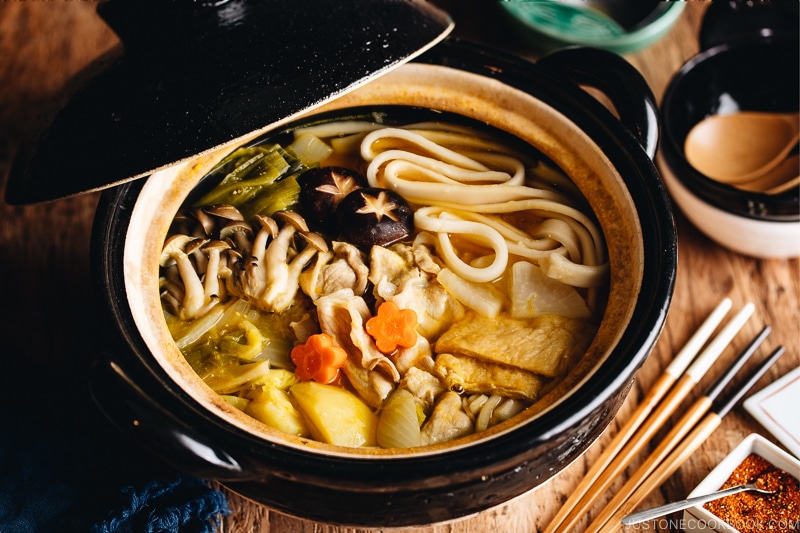
Explore Japan’s Regional Foods
Part of the fun of visiting Japan is the endless opportunity of trying out its multifaceted regional foods. And the great news is – you can recreate these flavors at home with the regional food recipes I’ve shared on Just One Cookbook. I hope you enjoy making Hoto Noodle Soup, and if you have any recipe request for Japan’s regional food, just leave a comment below!
Japanese Ingredient Substitution: If you want to look for substitutes for Japanese condiments and ingredients, click here.
Sign up for the free Just One Cookbook newsletter delivered to your inbox! And stay in touch with me on Facebook, Pinterest, YouTube, and Instagram for all the latest updates.
Hoto Noodle Soup

Filled with starchy vegetables, meat, and flat noodles in miso-based dashi broth, this hearty noodle soup called Hoto is a popular regional food from Yamanashi prefecture in Japan.
Dashi (anchovy + kombu)
- ¾ cup iriko (dried baby sardines/anchovies) ((30 g))
- 1 piece kombu (dried kelp) ((5 g, 1.5” x 3.5”))
- 5 cups water ((1200 ml))
Hoto Ingredients
- ⅛ kabocha squash/pumpkin ((180 g with seeds))
- 1 inch daikon radish ((120 g))
- ⅓ carrot
- 1 potato
- ¼ onion
- 2 leaves napa cabbage
- ½-1 leek ((or negi/long green onion))
- ½ shimeji mushrooms ((50 g))
- 2 shiitake mushrooms
- 1 aburaage (deep fried tofu pouch)
- 6 oz sliced pork loin
- 7.8 oz Hoto noodles (uncooked) ((220 g) (or 18 oz/500 g frozen sanuki udon noodles or see Notes for homemade))
Seasonings
- 4 Tbsp sake
- 2 Tbsp mirin
- 5-6 Tbsp miso
- salt (kosher or sea salt; use half if using table salt) ((to taste))
To Serve
- Shichimi Togarashi (Japanese seven spice) ((for spicy))
- Gather all the ingredients.
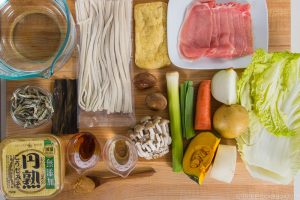
Make Dashi
- Soak the kombu in 5 cups water.
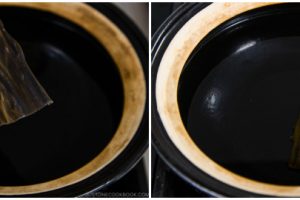
- Remove the head and gut (inside the tummy area) of anchovies. If you’re not sure where the gut is, it’s the black thing inside the tummy area. This will reduce the bitter flavor in dashi.
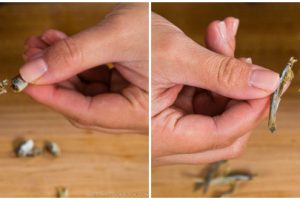
-
Put the clean anchovies (left piles) in a tea bag (or cheesecloth) and discard the remains.
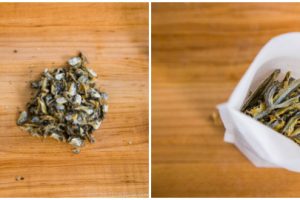
-
Add the bag to the kombu dashi, cover, and slowly bring to almost a boil on low heat.
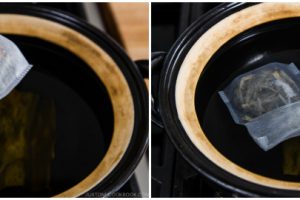
- Once almost boiling, remove the kombu and continue to cook anchovies for another 10 minutes. Skim the foam/scam while cooking. After 10 minutes, remove the bag of anchovies. Set aside.
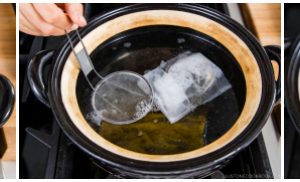
Prepare Ingredients
- Remove the seeds of kabocha squash and cut it into 1-inch cubes.
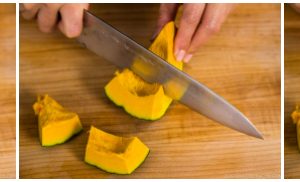
- Cut daikon into half and cut into ¼ inch slices. Then cut them in half.
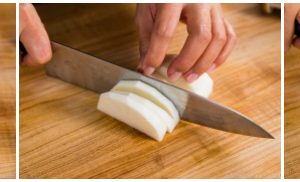
- Cut carrot into ¼ inch thick rounds. If you like, you can cut out into a flower shape.
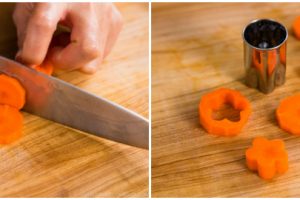
- Cut the potato into small pieces and cut the onion into ½ inch slices.
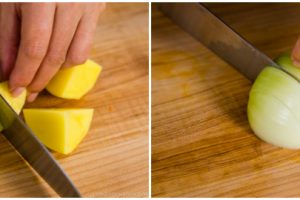
-
Cutting the napa cabbage into smaller pieces, especially the bottom tougher part of the leaves.
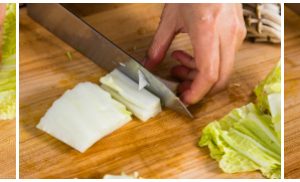
- Cut the leeks into 2-inch pieces. Cut each tube piece into quarters lengthwise.
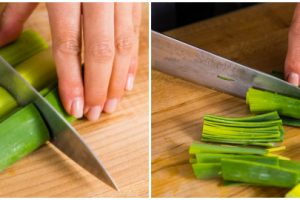
- Cut the bottom of shimeji mushroom and shiitake mushrooms.
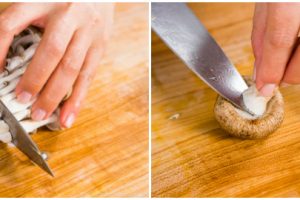
- [Optional] You make a decorative flower shape on the cap of shiitake mushrooms. See the post here.
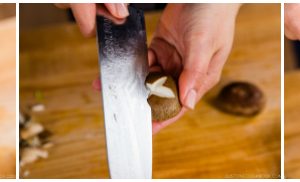
- Pour boiling water over Aburaage to remove oil and cut into 4 pieces.
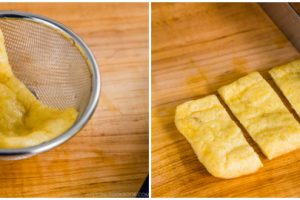
- Now all the ingredients are ready to be cooked.
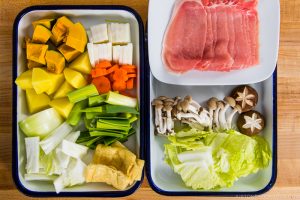
Cook Hoto
-
Heat the dashi over medium heat and start cooking tough vegetables first, such as leeks, onion, daikon, the bottom part of napa cabbage, potatoes, kabocha, etc.
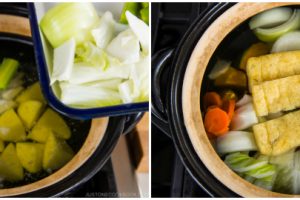
- Once boiling, add the thinly sliced pork (separate each slice).
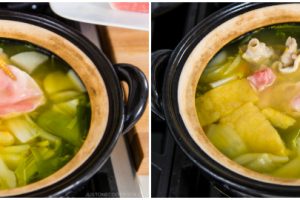
- Add 4 Tbsp sake and 2 Tbsp mirin. Bring it to boil. Once boiling, add the rest of ingredients and hoto noodles.
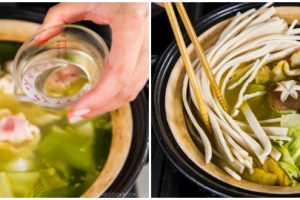
- Bring it back to boil again and skim the foam/scum as you cook.
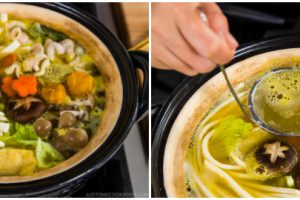
- Add the 5-6 Tbsp miso (varies depending on the type of miso) and continue to cook on simmer until noodles and all the ingredients are cooked through, about 10-15 minutes.
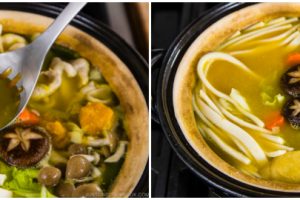
- Always check the flavor. Add salt to taste and add more miso if necessary. Serve hot and enjoy! We usually bring the donabe to the table with a portable gas burner stove and serve into individual bowls. Sprinkle Shichimi Togarashi if you like it spicy.
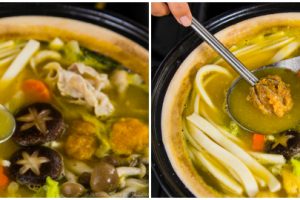
To make hoto noodles (for 4 servings):
- In a large bowl, combine 200 g all-purpose flour and 90 g water. Only if necessary, add a little bit of water. Transfer to a working surface.
- Knead until the dough becomes smooth texture and form a ball. Transfer back to the bowl and cover with plastic wrap for 10 minutes.
- Sprinkle the working surface with the extra flour and divide the dough into 2. Flatten each dough with the heal of your hand and roll out the dough using a rolling pin. Thickness should be 3-4 mm.
- Sprinkle flour on the working surface and fold the sheet of the dough into third or fourth and cut into 1 cm thickness.
- Divide the noodles into 2 (one half for this recipe, the other half for next batch of hoto – make sure to sprinkle extra flour so noodles don’t stick together).
Japanese Ingredient Substitution: If you want to look for substitutes for Japanese condiments and ingredients, click here.
Recipe by Namiko Chen of Just One Cookbook. All images and content on this site are copyright protected. Please do not use my images without my permission. If you’d like to share this recipe on your site, please re-write the recipe in your own words and link to this post as the original source. Thank you.d link to this post as the original source. Thank you.
Resource : https://ift.tt/2vMxpFu



No comments:
Post a Comment